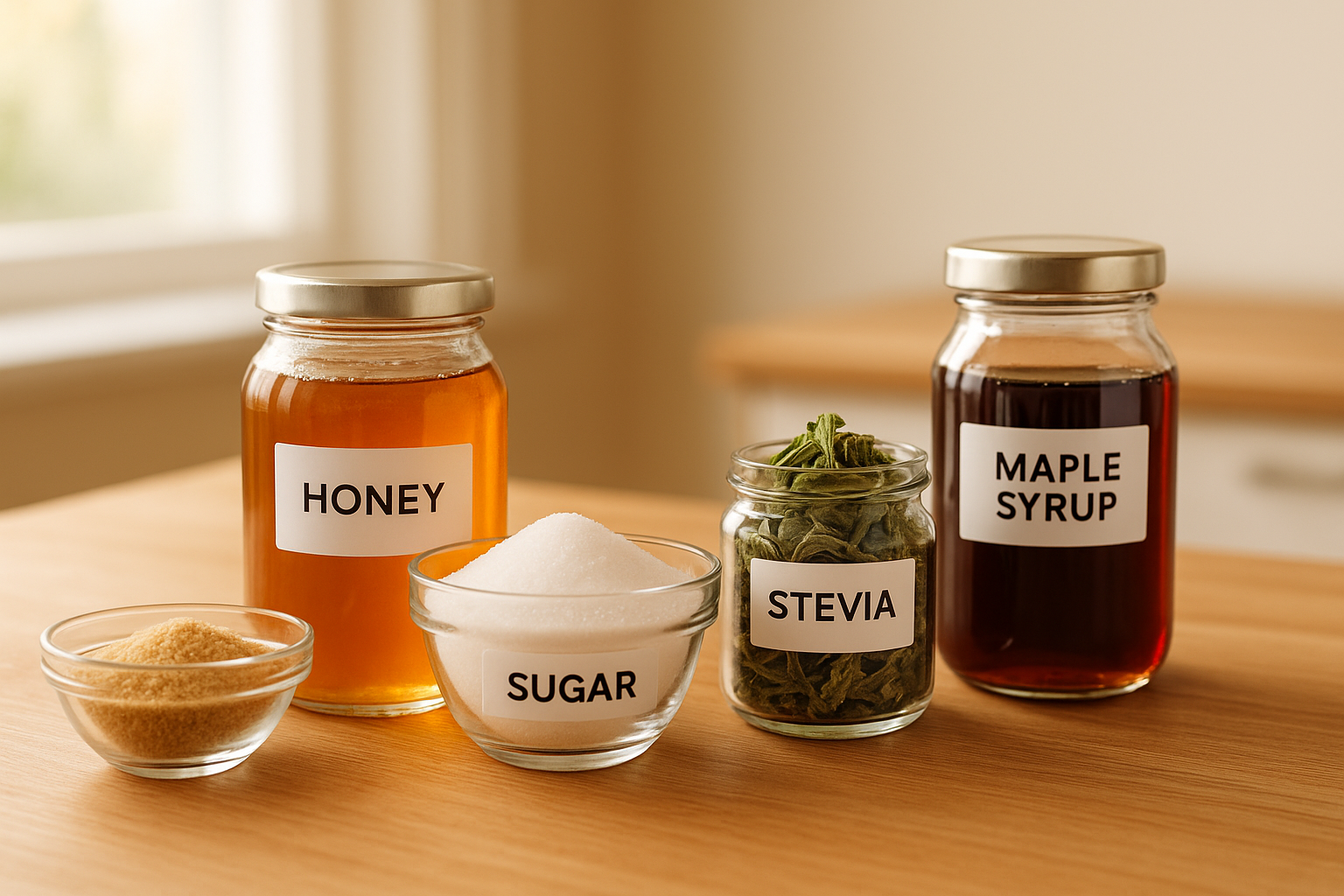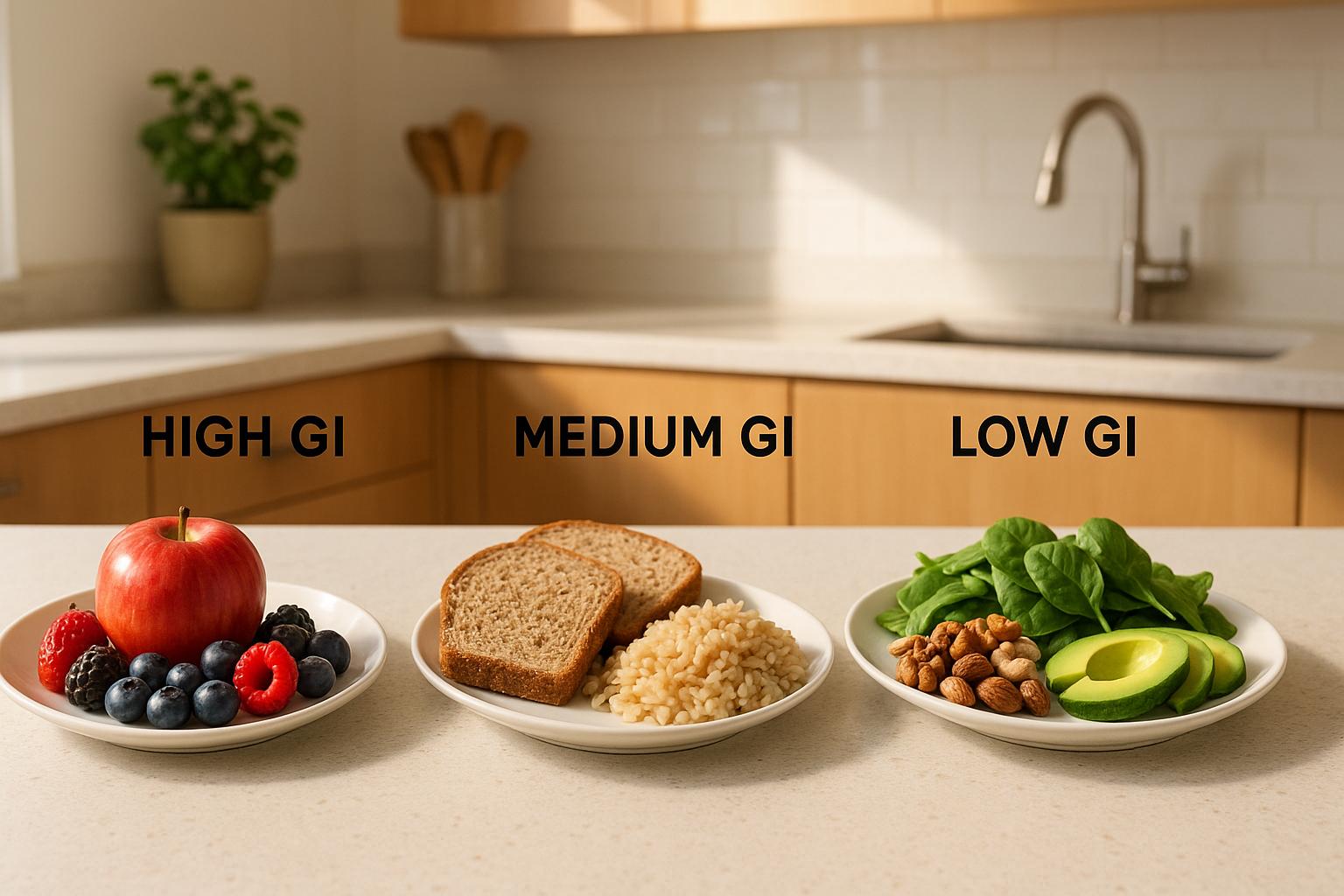Want to manage your blood sugar better? Start by understanding the Glycemic Index (GI).
The GI measures how quickly foods raise your blood sugar on a scale from 0 to 100. Here's a quick breakdown:
- Low GI (55 or less): Gradual blood sugar increase (e.g., lentils, sweet potatoes).
- Medium GI (56–69): Moderate rise (e.g., whole wheat bread).
- High GI (70 or above): Rapid spikes (e.g., white bread, puffed rice).
Key Takeaways:
- Low-GI foods help stabilize blood sugar and support weight management.
- High-GI foods can lead to sugar spikes, cravings, and insulin resistance.
- Check food labels for GI claims or focus on total carbs, fiber, and added sugars.
Tip: Pair high-GI foods with protein, fiber, or healthy fats to slow digestion.
Read on for tips to identify GI-friendly foods and make smarter choices!
Finding GI Information on Food Labels
GI Labels and Claims
The availability of glycemic index (GI) information on food labels varies greatly depending on the country. In the United States, GI claims like "low GI" or "GI-friendly" can appear on packaging under general food-labeling rules, but they aren't specifically regulated. This means it's important to carefully evaluate such claims. In contrast, some countries have more defined systems for GI labeling:
| Country | GI Label Type | Requirements |
|---|---|---|
| Australia/New Zealand | Certified Low GI Trademark | Products must be tested per ISO 26642:2010 standards and meet strict nutrient criteria |
| Singapore | Healthier Choice Symbol | Includes specific guidelines for low GI claims based on food categories |
| South Africa | GIFSA Symbols | Products are categorized as Very Low, Low, Medium, or High GI |
Nutrition Facts and GI
If GI values aren't listed on the packaging, you can still use the Nutrition Facts panel to estimate a product's glycemic effect. Focus on these key details:
- Total Carbohydrates: A helpful starting point for assessing blood sugar impact.
- Dietary Fiber: Foods with more fiber typically cause a smaller rise in blood sugar.
- Added Sugars: Higher amounts often suggest a higher GI.
- Sugar Alcohols: These tend to have a smaller effect on blood sugar compared to regular sugars.
In regions like Australia and New Zealand, products with the GI Symbol must meet strict nutritional standards, including limits on energy, carbohydrates, saturated fat, sodium, and, in some cases, fiber and calcium.
For places where GI labeling is less common - such as Canada or the European Union - it's useful to check the ratio of fiber to carbohydrates and look for whole grain ingredients. These factors can provide clues about a food's glycemic impact. Ultimately, focusing on the overall nutritional profile is essential for managing blood sugar levels effectively.
Low-GI Foods for Blood Sugar Control
Top Low-GI Food Choices
Low-GI foods, with a glycemic index (GI) below 55, help keep blood sugar levels steady. For instance, non-starchy vegetables like raw carrots (GI 16) and legumes such as boiled kidney beans (GI 23) and green lentils (GI 22) are great options.
Here’s a quick look at some low-GI foods by category:
| Food Category | Examples | GI Score |
|---|---|---|
| Dairy Products | Semi-skimmed milk | 34 |
| Legumes | Chickpeas | 28 |
| Root Vegetables | Boiled sweet potato | 44 |
| Protein-Rich Foods | Eggs, meat, fish | N/A (no carbs) |
Identifying Low-GI Foods Without Labels
When packaged foods don’t list GI values, the following tips can help you estimate their glycemic effect:
- Fiber Content: Foods with higher fiber compared to total carbohydrates generally have a lower glycemic impact.
- Protein and Fat Levels: Items rich in protein or healthy fats usually score lower on the GI scale. For instance, full-fat milk has a GI range of 3 to 41, showing how fat content can make a difference.
- Processing Level: Choose whole, less-processed grains like whole wheat pasta, brown rice, or steel-cut oats instead of refined options.
- Preparation Method: Cooking methods affect GI scores. For example, raw carrots have a lower GI than cooked ones, and boiled sweet potatoes rank lower than baked, peeled versions.
A useful trick: cooking, cooling, and then reheating starchy foods like rice, potatoes, or pasta increases resistant starch, which can lower their glycemic impact.
High-GI Foods to Watch
Common High-GI Foods
Knowing which foods have a high glycemic index (GI of 70 or above) is important for managing blood sugar levels. These foods can trigger a quick release of insulin.
Here are some examples of high-GI foods:
| Food Category | Item | GI Score |
|---|---|---|
| Grains | White basmati rice | 84 |
| Breads | White bread | 83 |
| Snacks | Puffed rice cakes | 91 |
| Breakfast | Instant oats | 76 |
| Beverages | Low-fat rice milk | 92 |
These foods are known to cause sharp spikes in blood sugar.
"Eating high-GI foods can cause blood sugar levels to rapidly rise - triggering the pancreas to release more insulin - and then quickly fall. This can promote cravings and overeating. Repeating this cycle frequently may lead to weight gain and insulin resistance, factors associated with type 2 diabetes and higher cardiovascular risk." - Matthew Solan, Executive Editor, Harvard Men's Health Watch
Research from 2016 also found that diets with a high glycemic load were linked to a 38% higher risk of depressive symptoms and 26% higher fatigue scores.
Hidden High-GI Ingredients
Some processed foods contain ingredients that can raise glycemic responses, even if this isn’t obvious from the packaging. Reading labels closely can help you spot these hidden culprits.
Common Hidden Sugar Forms:
- Corn syrup and high fructose corn syrup
- Agave nectar
- Brown rice sugar
- Maltose and galactose
- Beet sugar
- Molasses
Refined Grains to Look Out For:
- Enriched flour
- White flour
- Rice flour
- Modified food starch
Cooking methods also play a role in a food's GI. For example, pretzels have a GI of 83, while corn chips range from 41 to 75.
Check both the ingredient list and Nutrition Facts panel to spot hidden sugars and refined grains. Ingredients are listed by weight, so if multiple forms of sugar or refined grains appear near the top, the product is likely high-GI.
sbb-itb-0899721
Daily GI Management Tips
Mixed-GI Meal Planning
Managing your daily glycemic index (GI) doesn't mean cutting out high-GI foods completely. Instead, aim for balanced meals that include a mix of low- and higher-GI foods to help keep blood sugar levels steady. Studies suggest that combining low-GI carbs with protein and healthy fats can improve blood sugar control and even support weight management.
Here are some practical ways to include higher-GI foods while keeping meals balanced:
- Pair high-GI carbs with protein or healthy fats to slow digestion.
- Add fiber-rich vegetables to help moderate blood sugar spikes.
- Watch portion sizes when eating higher-GI foods.
- Stick to three main meals a day to reduce blood sugar swings.
Smart GI Shopping Guide
Bring these meal planning tips to the grocery store to make choices that support stable blood sugar levels. Even if GI values aren’t listed on packaging, you can shop smarter by focusing on specific food types.
Here’s what to consider:
- Produce: Go for non-starchy vegetables like asparagus, cabbage, and mushrooms. Choose less ripe fruits, as ripeness can increase GI. Citrus fruits and berries are great options since they usually have lower GI scores.
- Grains and Starches: Pick products labeled "whole grain" as a main ingredient. Opt for traditional items like steel-cut oats instead of instant varieties, and cook pasta al dente to keep its GI lower.
- Dairy and Alternatives: Select whole milk or unsweetened plant-based options. Choose plain yogurt over flavored ones, and avoid products with added sugars.
When buying packaged foods, always check the ingredient list and nutrition facts. Items with multiple added sugars or refined grains often have higher GI values. To manage blood sugar effectively, aim for foods with a GI of 55 or less.
How to Correctly Read Food Labels | Ultimate Diabetes Guide
Key Takeaways
Here’s a summary of the main points:
Using GI (Glycemic Index) information on food labels can be a highly effective way to manage blood sugar levels. Studies show that combining GI with available carbohydrate data explains 85–94% of the variation in blood sugar responses to single foods. This makes GI a critical factor in daily dietary decisions.
Practical GI Guidelines:
- Choose foods with a GI of 55 or less to avoid sharp blood sugar spikes.
- Be cautious with foods that have a GI of 70 or higher, as they can cause rapid increases in blood sugar.
- Keep in mind that factors like the ripeness of fruits and cooking methods can change a food's GI.
Tips for Reading Labels:
- Look for GI symbols or claims on food packaging.
- Always consider portion sizes in addition to GI values.
- Remember, highly processed foods typically have a higher GI.
When grocery shopping, focus on whole and minimally processed foods. For example, pick steel-cut oats over instant oats or go for al dente pasta instead of soft-cooked pasta to help maintain steadier blood sugar levels.
With diabetes affecting 1 in 11 adults worldwide, these strategies are beneficial not just for those with diabetes but for anyone looking to improve blood sugar management. Research also shows that swapping high-GI foods for low-GI options can significantly enhance blood sugar control in people with diabetes.



